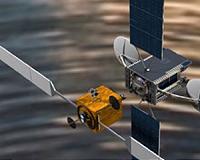 |
Redondo Beach CA (SPX) Jan 19, 2011 The effectiveness of the Space Tracking and Surveillance System (STSS) Demonstration satellites has been expanded after a communications crosslink was activated and successfully tested by Northrop Grumman, prime contractor, and Raytheon, sensor payload provider. The radio frequency (RF) relay between the missile defense satellites establishes communications between one spacecraft that is out of view of a ground station through the other satellite, which is in range, according to Doug Young, vice president of Missile Defense and Warning programs for Northrop Grumman's Aerospace Systems sector. "The crosslink expands the regions of the world where both satellites are in communication, enabling closure of the fire control loop with missile defense interceptors," Young said. "The ability to acquire and hand-off timely tracked data from the infrared sensors on board STSS to the Ballistic Missile Defense System's intercept chain is a critical capability for destroying targets as early as possible during their flight." The Missile Defense Integration and Operations Center at Schriever Air Force Base, Colo., receives and processes data from the STSS Demonstration satellites. Connectivity is provided through the Air Force Satellite Control Network in near real-time. The missile tracking capability being demonstrated by the STSS Demonstration program will mature the design and concepts of operation for a future operational constellation. The operational constellation will be designed to enable earlier intercepts of threat missiles and to significantly improve missile defense capabilities for the nation, deployed forces and allies.
Share This Article With Planet Earth
Related Links - Space Technology News - Applications and Research
 ViviSat Launched
ViviSat LaunchedDulles VA (SPX) Jan 17, 2011 U.S. Space and ATK have announced the creation of ViviSat, a new satellite life extension venture. ViviSat provides geosynchronous satellite operators with flexible, scalable, capital-efficient, and low-risk in-orbit mission extension and protection services that can add several years to the revenue-producing life of a satellite. ViviSat's Mission Extension Vehicle (MEV) is designed to doc ... read more |
|
| The content herein, unless otherwise known to be public domain, are Copyright 1995-2010 - SpaceDaily. AFP and UPI Wire Stories are copyright Agence France-Presse and United Press International. ESA Portal Reports are copyright European Space Agency. All NASA sourced material is public domain. Additional copyrights may apply in whole or part to other bona fide parties. Advertising does not imply endorsement,agreement or approval of any opinions, statements or information provided by SpaceDaily on any Web page published or hosted by SpaceDaily. Privacy Statement |